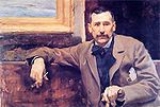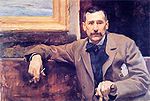
Benito Pérez Galdós
Encyclopedia

Spanish Realist literature
Spanish Realist literature is the literature written in Spain during the second half of the 19th century, following the Realist movement which predominated in Europe....
novelist. Considered second only to Cervantes
Cervantes
-People:*Alfonso J. Cervantes , mayor of St. Louis, Missouri*Francisco Cervantes de Salazar, 16th-century man of letters*Ignacio Cervantes, Cuban composer*Jorge Cervantes, a world-renowned expert on indoor, outdoor, and greenhouse cannabis cultivation...
in stature, he was the leading Spanish realist
Literary realism
Literary realism most often refers to the trend, beginning with certain works of nineteenth-century French literature and extending to late-nineteenth- and early-twentieth-century authors in various countries, towards depictions of contemporary life and society "as they were." In the spirit of...
novelist.
He was born in Las Palmas de Gran Canaria
Las Palmas de Gran Canaria
Las Palmas de Gran Canaria commonly known as Las Palmas is the political capital, jointly with Santa Cruz, the most populous city in the Autonomous Community of the Canary Islands and the ninth largest city in Spain, with a population of 383,308 in 2010. Nearly half of the people of the island...
, Canary Islands
Canary Islands
The Canary Islands , also known as the Canaries , is a Spanish archipelago located just off the northwest coast of mainland Africa, 100 km west of the border between Morocco and the Western Sahara. The Canaries are a Spanish autonomous community and an outermost region of the European Union...
, and, when nineteen years old, he moved to Madrid
Madrid
Madrid is the capital and largest city of Spain. The population of the city is roughly 3.3 million and the entire population of the Madrid metropolitan area is calculated to be 6.271 million. It is the third largest city in the European Union, after London and Berlin, and its metropolitan...
, where he spent most of his adult life. In Spain, his most popular works are the early Episodios nacionales
Episodios Nacionales
The Episodios Nacionales are a collection of forty-six historical novels written by Benito Pérez Galdós between 1872 and 1912. They are divided into five series and they deal with Spanish History from roughly 1805 to 1880...
(46 volumes) and Fortunata y Jacinta
Fortunata y Jacinta
Fortunata y Jacinta , was written by Benito Pérez Galdós in 1887. It is, together with Leopoldo Alas y Ureña's La Regenta , one of the most popular and representative novels of Spanish literary realism. Born in Las Palmas de Gran Canaria, Canary Islands, the author went to Madrid, the capital, to...
, while outside Spain his Novelas españolas contemporáneas are better known.
The early novels mix historical and fictional characters and are the result of documentary research. As in Balzac
Honoré de Balzac
Honoré de Balzac was a French novelist and playwright. His magnum opus was a sequence of short stories and novels collectively entitled La Comédie humaine, which presents a panorama of French life in the years after the 1815 fall of Napoleon....
's novels, some characters reappear in different novels. They cover the time from 1805 to the end of the 19th century, providing glimpses of Pérez Galdós's radical and anti-clerical views, which are developed in the contemporary novels. In Doña Perfecta
Doña Perfecta
Doña Perfecta is a 19th century realist novel by Benito Pérez Galdós from what is called the first of Galdós's three epochs in his novels of social analysis.-Plot summary:...
(1876) a young radical arrives to a stiflingly clerical town. In Marianela (1878) a young man regains his eyesight after a life of blindness and rejects his best friend Marianela for her ugliness. In Miau
Miau
Miau is a realistic novel by Spanish writer Benito Pérez Galdós, released in 1888. It tells a story about a middle-low class family of Madrid in the 19th century. The main character is Ramón Villaamil, an ex-employée from the Ministry of Economy and Finance...
(1888) a pretentious family lose their livelihood when the father, an aged civil servant, loses his job because of a change in government, and eventually kills himself.
Pérez Galdós's masterpiece is Fortunata y Jacinta
Fortunata y Jacinta
Fortunata y Jacinta , was written by Benito Pérez Galdós in 1887. It is, together with Leopoldo Alas y Ureña's La Regenta , one of the most popular and representative novels of Spanish literary realism. Born in Las Palmas de Gran Canaria, Canary Islands, the author went to Madrid, the capital, to...
(1886–1887). Almost as long as War and Peace, it concerns the fortunes of four characters: a young man-about-town, his wife, his lower-class mistress, and her husband. Ángel Guerra (1891) tells of an unbalanced man who attempts to win a devout and inaccessible woman, swinging from agnosticism
Agnosticism
Agnosticism is the view that the truth value of certain claims—especially claims about the existence or non-existence of any deity, but also other religious and metaphysical claims—is unknown or unknowable....
to Catholicism
Catholicism
Catholicism is a broad term for the body of the Catholic faith, its theologies and doctrines, its liturgical, ethical, spiritual, and behavioral characteristics, as well as a religious people as a whole....
in the process.
In 1886 then prime minister Práxedes Mateo Sagasta
Práxedes Mateo Sagasta
Práxedes Mariano Mateo Sagasta y Escolar was a Spanish politician who served as Prime Minister on eight occasions between 1870 and 1902—always in charge of the Liberal Party—as part of the turno pacifico, alternating with the Liberal-Conservative leader Antonio Cánovas...
appointed him as the (absent) deputy for the town and district of Guayama, Puerto Rico
Puerto Rico
Puerto Rico , officially the Commonwealth of Puerto Rico , is an unincorporated territory of the United States, located in the northeastern Caribbean, east of the Dominican Republic and west of both the United States Virgin Islands and the British Virgin Islands.Puerto Rico comprises an...
at the Madrid parliament
Cortes Generales
The Cortes Generales is the legislature of Spain. It is a bicameral parliament, composed of the Congress of Deputies and the Senate . The Cortes has power to enact any law and to amend the constitution...
; he never visited the place, but had a representative inform him of the status of the area, and felt a duty to represent its inhabitants appropriately. In 1897, Pérez Galdós was elected to the Real Academia Española
Real Academia Española
The Royal Spanish Academy is the official royal institution responsible for regulating the Spanish language. It is based in Madrid, Spain, but is affiliated with national language academies in twenty-one other hispanophone nations through the Association of Spanish Language Academies...
(Royal Spanish Academy). In 1907 he became a deputy for the Republican Party in the parliament. He went blind in 1912 but continued to dictate his books for the rest of his life. Pérez Galdós died at the age of 76. Shortly before his death, a statue in his honour was constructed in the Parque del Retiro
Parque del Retiro
Parque del Retiro is the only senior citizens-oriented passive park in Ponce, Puerto Rico. It is located in barrio Canas Urbano. The park commemorated its 30th anniversary on February 11, 2010. It has a "steady attendance" of some 70 senior citizens...
, the most popular park in Madrid, financed solely by public donations.
Galdós was a prolific writer, publishing 31 novels, 46 Episodios Nacionales (National Episodes), 23 plays, and the equivalent of 20 volumes of shorter fiction, journalism and other writings. He remains popular in Spain, and galdosistas (Galdós researchers) considered him Spain's equal to Dickens, Balzac and Tolstoy. As recently as 1950, few of his works were available translated to English, although he has slowly become popular in the Anglophone world.
While his plays are generally considered to be less successful than his novels, Realidad (1892) is important in the history of realism in the Spanish theatre.
His novels have yielded many cinematic adaptations: Beauty in Chains (Doña Perfecta) was directed by Elsie Jane Wilson
Elsie Jane Wilson
Elsie Jane Wilson was a cinema actress, director and writer.Wilson was born in New Zealand. A professional actress from the age of two, she followed her husband Rupert Julian to United States in 1913, where both found work as actors in Universal silent movies. He turned to directing, with Wilson...
in 1918; Viridiana
Viridiana
Viridiana is a 1961 Spanish-Mexican motion picture, directed by Luis Buñuel and produced by Mexican Gustavo Alatriste. It is loosely based on Halma, a novel by Benito Pérez Galdós....
(1961), by Luis Buñuel
Luis Buñuel
Luis Buñuel Portolés was a Spanish-born filmmaker — later a naturalized citizen of Mexico — who worked in Spain, Mexico, France and the US..-Early years:...
, is based upon Halma; Buñuel also adapted Nazarín
Nazarín
Nazarín is a 1959 Mexican film directed by Luis Buñuel and co-written between Buñuel and Julio Alejandro, adapted from the eponymous novel of Benito Pérez Galdós...
(1959) and Tristana
Tristana
Tristana is a 1970 Spanish film directed by Luis Buñuel. Based on the eponymous novel by Benito Pérez Galdós, it stars Catherine Deneuve and Fernando Rey and was shot in Toledo, Spain. The voices of French actress Catherine Deneuve and Italian actor Franco Nero were dubbed to Spanish...
(1970); La duda was filmed in 1972 by Rafael Gil
Rafael Gil
Rafael Gil was a Spanish film director and screenwriter.- Filmography :*El hombre que se quiso matar .*Huella de luz. . –script too-*Viaje sin destino...
; El Abuelo (1988) (The Grandfather), by José Luis Garci
José Luis Garci
José Luis Garci is a producer, critic, TV presenter, writer, screenwriter and film director in Spanish cinema. He earned worldwide acclaim and his country's first Best Foreign Language Film Oscar for Begin the Beguine...
, was internationally released a year later; it previously had been adapted as the Argentine film, El Abuelo (1954).
The Galdós museum in Las Palmas, Gran Canaria, features a portrait of the writer by Joaquín Sorolla.
External links
- The Pérez Galdós Editions Project
- Galdós site, Biblioteca Virtual Miguel de Cervantes
- The Galdós House Museum. The Museum is set up in Pérez Galdós' birth place in Gran Canaria.
- Benito Pérez Galdós Published in The Cambridge History of Spanish Literature (2004)

